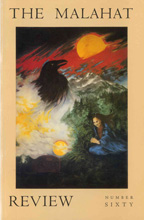Issues
Our Back Pages
Issue 60
Issue Date: October, 1981
Editor: Robin Skelton
Pages: 183
Number of contributors: 18
Buy Issue 60: Print Edition

Issue #60 is the third of a series called The West Coast Renaissance edited by Charles Lillard. The renaissance in question here is the revival in “North-west Indian cultures,” reflected in myths, folktales, stories, essays and poems celebrating the richness of First Nations art and literature. The editors go to some lengths to explain that the “west coast” is more accurately understood as a society rather than a geographical location, that it is not just confined to Canada, but covers an 800 mile stretch of coastline from Alaska to Puget Sound. Many of the contributors are American, some are English, one is French, and only a minority are First Nations. The issue is very much an appreciation, but I had a sense of looking at these tribal cultures from outside, from a Western perspective rather than from within, in a time before there were any worries about appropriation or calling First Nations Peoples Indians.
Among the highlights are excerpts from the German anthropologist and ethnographer Franz Boas’ (1848-1942) collection of myths and legends from the North Pacific Coast, first published in 1895. There is a tale of a killer whale who takes a woman to the bottom of the sea, a maid who wants to marry the sun, wolves pursuing a man and being turned into mountains, entry points into a vibrant mythological world. Many of the poems included here speak of ravens and dreamers, waterfalls and the northern lights, the natural world potent and dazzling as in Duane Niatum’s poem, “Cedar Man”: He kneels to cup the water / To his lips, salt his spirit / With the way fools dance in a fog. / He feels the currents that swirl / In an octopus’s eye.
At the time of this issue, 1981, west coast indigenous art was entering a renaissance in Vancouver’s art scene, and in fact around the world. Gallery owner Bill Ellis writes of Haida art as “a great revelation of the great truths by which the peoples lived” and predicts that recognition of its greatness will help to heal its battered people. Artist Carl Hall delves deeply into the symbolic roots of indigenous design elements in the ever-shifting coastal waters. A four page photo spread depicts the progress of Bill Reid’s superb carving of the creator Raven discovering human beings inside a cockle shell before creating a world for them at U.B.C.’s Museum of Anthropology.
The issue ends on an amusing note with an essay by the prolific writer and anarchist George Woodcock. “The West of the Island” is an account of his rather disastrous attempts at homesteading in Sooke on Vancouver Island, after coming out from England with his wife in 1949. After trying to sell their vegetables and pick strawberries for a living, and nearly starving, Woodcock returned to England to write a book about his experiences, Ravens and Prophets.
—Sheila Munro









